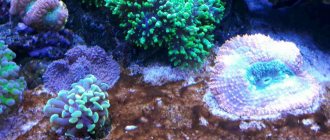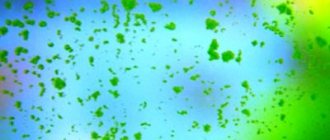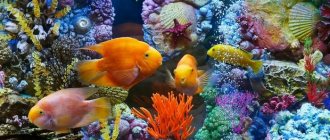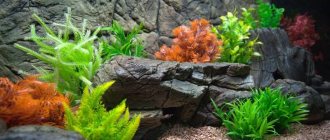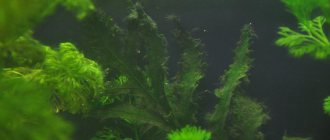What is algae
An aquarium is not only fish, it is an entire underwater world in which many other inhabitants coexist - mollusks, fungi, bacteria, plants and algae. Even if they are not visible at first glance, they are all nevertheless necessary elements of a closed ecosystem that exists in a certain balance.
Algae are the lowest form of aquatic plants. They can be colonial, unicellular or multicellular. They are studied by a special science - algology. In symbiosis with a fungus, they can form lichens and moss.
They should not be confused with cultivated higher aquatic plants.
Despite the fact that they may differ significantly in appearance and be of different colors, all lower aquatic plants are united by the presence of chlorophyll and the lack of differentiation.
Types of algae in the aquarium
There are a huge number of their species, more than 100 thousand. But they are all divided into 11 large groups:
- Blue-green or cyanobacteria;
- Glaucophytes;
- Red (crimson);
- Green;
- Charovayas (rays);
- Ochrophyta (brown, yellow-green, golden);
- Diatoms;
- Cryptophytes;
- Haptophytes;
- Euglenaceae.
For the growth and reproduction of algae, water, light and organic nutrition are sufficient. All these components are present in any aquarium, so they develop there quite quickly.
Aquarists divide them conventionally into “good” and “bad”. The latter pollute the environment of the reservoir and interfere with the normal functioning of its main inhabitants. The most common types found here are:
Green algae
Parasites that cause water blooms, forming filamentous deposits or connections in the form of tufts and brushes on cultivated plants, as well as greenish pinpoint lesions on the internal walls of the reservoir. This is, for example, green euglena or xenococus, cladophus, edogonium.
Like any others, they often form at the stage of organizing an aquarium. Since there are few inhabitants and higher plants in it, an excess of microelements and organic matter is created. Green algae introduced with any sprout begin to grow rapidly if the lighting is not organized correctly, the flow of oxygen is insufficient, and the tank itself is poorly cleaned and excess nitrates form in it. They are the beneficial food for the filament.
Brown diatoms
If the maintenance regime of the water system is violated, they easily form in the form of a brownish coating on walls, stones, snags, plants, and soil. Parasites can be easily removed with a sponge, but they grow back very quickly if the necessary measures are not taken.
Read more in the article about brown algae.
Blue-green algae
They form a film or mucus on any area in the reservoir. Their presence most often indicates poor water quality in the aquarium.
Red algae
These colonies can be of different colors; in appearance they resemble formations in the form of bunches or brushes. They are more typical for distribution in sea water, but some species are also formed in fresh water.
For aquarists, the real problem is the “black beard” and “flip-flop”.
Xenococus
These algae live in almost every aquarium, but begin to actively reproduce only when there is an imbalance in the system. They look like green dots that merge into a continuous coating, and slow-growing specimens - Anubias, Staurogyne, etc. - suffer most from xenococcus.
How to fight
- algae must be removed from surfaces using scrapers or improvised means (toothbrush, etc.);
- Gyrinocheilus or Otocinclus fish can be used as natural enemies;
- Aquayer Algaecide + CO2 is recognized as an effective remedy - the drug needs to be treated with a syringe on contaminated surfaces, turning off the filters for half an hour;
- Tropical Algin (1 ml per 10 liters of water) and JBL Algol (100 ml bottle of product is designed to treat 400 liters of water) give a good effect;
- in an infected aquarium, it is recommended to plant fast-growing plants (hornwort, vallisneria, hygrophila) to regulate excess nutrients, which causes the appearance of xenococus.
After cleaning the aquarium, you need to adjust the lighting - red and “cold” lamps should predominate, and yellow light increases the likelihood of xenococcus occurring.
Mr. Tail explains why algae appears in an aquarium
The reason for the appearance of diatoms, filamentous and any other algae in a newly organized aquarium is an excessive percentage of organic components and carbon in the aquatic environment. The few still cultivated plants and living inhabitants are simply not able to absorb these surpluses.
But if brown or green colonies occupy the space of an already formed aquarium, then we can only talk about a violation of the conditions of its maintenance.
The main reasons for their abundant reproduction:
- Insufficient lighting. Although light is necessary for the reproduction of this single-celled parasite, its favorite existence is partial shade.
- Excess light has a great influence on the rate of algae reproduction, so it is as undesirable as its lack.
- Excessive percentage of iodine in water.
- A large amount of nitrates and nitrites in the aquarium.
- Low carbon dioxide levels.
- High acidity of water.
- Excessive silicate content - sand, limestone.
How to get rid of algae in an aquarium
In addition to brown algae, there are other parasites in the aquarium that appear as green, white or black mucus or plaque.
In any case, no matter what type of algae they are, the reason for their appearance is the same - an imbalance in the ecological system. Algae spores are present everywhere and can be introduced into the aquarium with new fish or cultivated plants.
If everything in the aquatic system is balanced, algae will exist as its integral part, providing food for some and shade for other inhabitants. But as soon as some kind of global imbalance occurs, it is followed by an algal outbreak. And if this happens, you need to get rid of algae in the aquarium urgently.
Control methods stem from the reasons that caused the outbreak of colony reproduction. Necessary:
- Find out what type of algae has affected the aquarium. There may be several of them.
- Analyze the condition of the reservoir and identify the reasons for its deterioration.
- Adjust the light mode. As a very basic measure, you can completely turn off the lighting for a few days. Sometimes such light relief turns out to be a very effective way of fighting.
- If the appearance of parasites is caused by insufficient daylight, then extend the lighting of the aquarium for several hours.
- It is likely that the problem is in the lamps themselves installed in the aquarium. They may simply not have enough power or light range. And sometimes simply replacing devices with suitable ones or upgrading the reservoir helps solve the problem.
- If the aquarium is contaminated with organic matter - dead plants, fish waste products, remains of living inhabitants, excess food, then the appearance of algae colonies is inevitable. In this case, the reservoir needs general cleaning. It is necessary to wash the soil, filters, decorative elements and plants, remove all debris, and uproot dying cultivated plants.
- Changing the water in the aquarium can be complete or partial, but it must be done regularly to prevent excess organic matter from stagnating.
Stagnation of organic matter not only causes rapid growth of lower plants. Its decomposition can lead to complete poisoning of the living environment with cyanide. Therefore, when cleaning the aquarium, it is necessary to use special preparations:
- Zeolite. Carbon in filters is not able to kill decomposing organic matter, so it is better to use a special resin as a filler - a mixture with zeolites, for example, Fluvar Zeo-Carb.
- Biostarters. These are drugs that contain bacteria that eat organic poisons. These are, for example, Tetra Bactozym, Tetra Nitrate Minuse and others.
Another important element in the fight against algae is higher cultivated aquatic plants. Aquariums that are half or two-thirds stocked with them do not experience parasitic outbreaks. Such plantings ensure sufficient carbon dioxide content and the required level of illumination in the reservoir.
Fish that eat algae are another component in the fight against parasites. These are Siamese, Indian, Chinese algae eaters. They effectively help in the destruction of “black beard,” “thread,” and “deer horns.” Catfish, such as Otocinclus and Ancistrus, are good at cleaning walls and eating green and brown algae from plants and decorative elements. In addition, you can use guppies, mollies, platies, swordtails, and all types of mollusks (ampularia, physes, and others).
Aquarium chemicals with the word “Algo” in their name are designed to kill parasitic algae. This is, for example, Tetro Algo Stop Depot.
They must be used strictly according to the instructions. A special chemical agent, Elodea, releases antibacterial substances that are harmful to blue-green algae.
In general, all methods of combating any algae in an aquarium can be divided into 4 main groups:
- Mechanical - removal using improvised means, such as scrapers and brushes.
- Physical - consists of selecting optimal temperature, light, acidity, and water hardness conditions.
- Chemical - the use of special substances that inhibit the growth of algae.
- Biological - adding inhabitants to aquariums that actively devour colonies of lower plants. These are mollusks, catfish, snails, crayfish.
Catfish for cleaning an aquarium
To combat algae, it is necessary to use all methods in combination.
Black beard
A type of algae that feeds on organic debris and resembles weaves of black or green fibers. Blackbeard quickly covers plants and aquarium surfaces and can be difficult to control.
How to fight
Natural enemies
To eliminate black beard, you can use the Siamese algae eater.
To keep the aquarium clean, it is enough to keep 2 small fish in the tank. The disadvantage is that in the absence of algae, they may begin to feed on mosses or other plants.
You can use rednose shrimp (Caridina gracilirostris), but they are quite difficult to keep.
Sidex
- This product is used in medicine to disinfect surfaces, but recently it has been recommended to combat black beard.
- Sidex is poured once a day at a dosage of 10-15 ml per 100 liters of water. Gradually the dosage is increased to 20-25 ml, the full course is about 2 weeks.
- Aquascapers and aquarists who have used this method in practice claim that it does not harm fish or plants, but it is better not to increase the dose. There were cases when, when more than 30 ml of the product was added, some inhabitants of the aquarium died.
Nathan Hill
Aquascaper and editor of PracticalFishkeeping magazine
Kill blackbeard with glutaraldehyde (25% solution and 75% water). The decorations must be kept in liquid, then rinsed and returned to the aquarium. After this, you need to add the substance in an amount of 4-8 ml per 50 liters for a week.
— Nathan Hill Aquascaper and editor of PracticalFishkeeping magazine
Chemicals
To combat black beard, you can use Aquayer Algaecide + CO2.
Dosage 4-8 ml per 50 liters of water for algae outbreak, treatment course is 3-7 days. For intensive treatment, you need to turn off the filters for half an hour and treat the contaminated surfaces with a syringe.
Acetic acid
Immerse the infected plants in a 3% solution (only the tops, do not touch the roots!), then rinse them in aquarium water and replant them.
You can use apple cider vinegar instead of acetic acid.
To prevent the reappearance of black beard, it is necessary to constantly siphon the soil, removing organic residues, and also pay attention to the choice of fish food - it should contain a minimum amount of phosphorus.
Preventing algae
Like any problem, the appearance of algae in an aquarium is easier to solve by using preventive measures than to fight them.
To do this, you should follow simple rules:
- Ensure correct lighting conditions. Additionally, use lamps with a red spectrum. The most vigorous algae growth occurs under cool blue light.
- Change the water regularly. This can be done gradually, adding new cleaned water and draining the contaminated one. Sometimes carry out a complete replacement, approximately once every 3-6 months, depending on the volume of the reservoir.
- Maintain the correct temperature. The optimal temperature for preventing rapid growth of algae is +22…+28 °C.
- Install special filters to capture excess organic matter in the aquarium.
- Plant many higher cultivated plants in the reservoir and monitor their normal development, taking timely care and removing dead parts. Vallisneria, hornwort and hygrophila grow very well in aquariums. Cladophora, a spherical algae, also kills its “bad” brothers.
- Products made of copper or zinc can be placed on the ground of the reservoir. They inhibit the growth of certain parasites, such as brown algae.
- Special chemical phosphate absorbers can be poured onto the bottom along with the soil.
- If the aquarium contains only fish and no plants, then you can use an ultraviolet sterilizer that kills algae spores.
- Before planting new plants in the aquarium, it is advisable to disinfect them. To do this, just hold them for a couple of minutes in a weak aqueous solution of dry bleach or bleach (1:19), and then rinse thoroughly.
- Regularly thoroughly clean the aquarium using special chemicals.
Using hydrogen peroxide
Unfortunately, it is not always possible to purchase antibiotics and not everywhere. In this case, you can use another drug that is freely sold in any pharmacy. We are talking about simple hydrogen peroxide. When using it, the treatment process takes longer, but the result is also simply wonderful.
There is no need to replant fish and snails, because hydrogen peroxide will not harm them. The main thing is to correctly calculate the appropriate ratio of water and drug. To achieve the desired result, it is enough to spend 25 milligrams of hydrogen peroxide on a 100-liter aquarium. It is added daily for three days.
Most often, by the end of the third day, the algae die off and their remains are easy to remove. At the same time, perform a water change - about 20-30 percent of the total volume of the aquarium.

